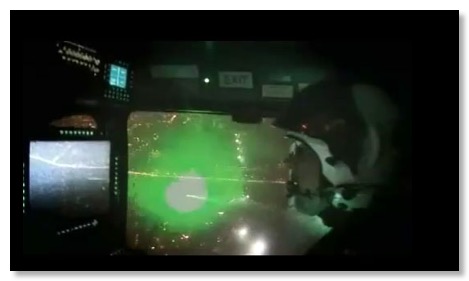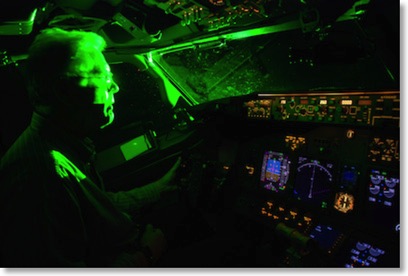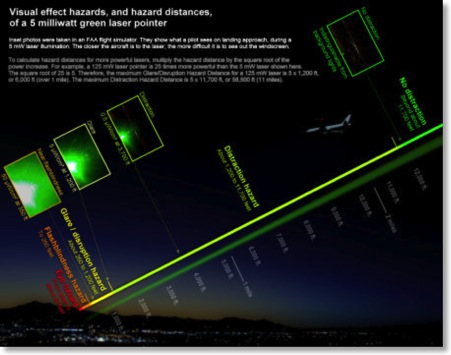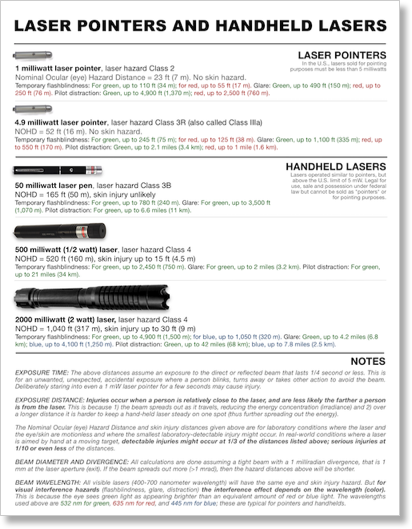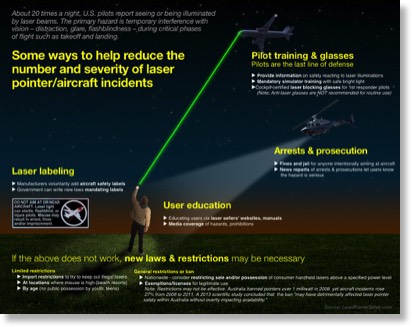Home
A comprehensive resource for safe and responsible laser use
For additional information visit the LaserPointerForums.com safety forum
For additional information visit the
LaserPointerForums.com safety forum
Concerned about laser pointers? Want them used safely?
While laser pens are useful and fun, they are all too often misused. This website has details such as…
- consumer eye injuries caused by laser pointers
- what makes bright laser light hazardous to aviation
- why you should never aim laser pointers at aircraft
- basic principles of laser hazards
- a laser pointer FAQ, and fast facts for media
- a video from the FAA and Air Force
- how to report a laser incident
- laser safety glasses for pilots
- how to safely simulate a laser strike
- an online Laser Hazard Distance Calculator
- an online Beam Diameter and Irradiance Calculator
- a 1-page "instant" laser safety officer course
- studies about aviation distraction hazards and general eye hazards
- consumer eye injuries caused by laser pointers
- what makes bright laser light hazardous to aviation
- why you should never aim laser pointers at aircraft
- basic principles of laser hazards
- a laser pointer FAQ, and fast facts for media
- a video from the FAA and Air Force
- how to report a laser incident
- laser safety glasses for pilots
- how to safely simulate a laser strike
… especially for laser safety experts …
- an online Laser Hazard Distance Calculator
- an online Beam Diameter and Irradiance Calculator
- a 1-page "instant" laser safety officer course
- studies about aviation distraction hazards and general eye hazards
Laser/aircraft illumination incident statistics
Informative charts and videos
A helicopter being deliberately targeted by a laser pointer. The light is a distraction and, if bright enough, can cause temporary flashblindness. It is NOT likely to cause any permanent injury. A video of this incident is here.
In most incidents, the beam only directly hits the aircraft windscreen a few times. That’s because it is almost impossible to hand-hold a laser onto a target hundreds or thousands of feet away. For example, these frames show 8 seconds of a laser illumination. Only in one of the frames — 1/2 second out of 8 — does a direct hit obscure the pilot’s vision. Of course, the waving beam is a distraction.
Public domain photo from the U.S. FAA, showing how a laser beam spreads over long distances and can fill the windscreen. The FAA’s highest-resolution version is here.
This diagram shows the hazard distances of a 5 mW green laser pointer. It is an eye hazard up to 52 feet from the laser, causes temporary flashblindness to 260 feet, causes glare and visual disruption to 1,200 feet, and is a distraction to 11,700 feet (2.2 miles). Click to enlarge.
This shows five typical battery-powered lasers, along with their eye and skin hazard distances, and the distances at which they can cause visual interference to persons such as aircraft pilots. Click to enlarge.
This diagram shows various ways to help reduce laser pointer incidents. These include: pilot training and glasses, arrests and prosecutions, laser labeling, user education, and new laws & restrictions. Click to enlarge.
“Dumb Ways to Blind” is a 2014 public service video that warns the Internet generation about the many ways lasers can be misused. As of February 2024, this has had almost 10 million views on YouTube.
In April 2019 the U.S. Federal Aviation Administration posted this animated powerpoint. The narration says "…pointing a laser at an aircraft can distract or temporarily blind the pilot, potentially putting the lives of many innocent passengers at risk. That's why it's a federal crime with serious consequences like fines up to $250,000 or up to five years in jail…"
Learn from his mistake — don’t aim lasers at aircraft
I also want to educate anyone who owns a laser and might be inclined to use it the way I did: Learn from my mistake. I am now just getting out of prison. I have paid dearly, for I have lost my girlfriend, my dog, my home, my vehicle. Everything I owned, everything I have worked for 30 years of my life, is gone.
For shining a laser at a helicopter for three seconds, I lost my entire life. I am now 54 years old and I have no one and nothing but the clothes I was given when I was released from prison.

NOTICE: CALCULATOR WILL NOT WORK
The calculator below will not work with Internet Explorer. You appear to be running Internet Explorer or another incompatible browser; if so, the results will not appear.
To allow this calculator to work, please use an up-to-date version of a browser such as Microsoft Edge, Mac Safari, Google Chrome, Firefox, etc. If you continue to have problems, contact us.
See how far lasers can be a hazard
The light level (irradiance) at the NOHD is at the Maximum Permissible Exposure or MPE. Farther than the NOHD, the irradiance falls below the MPE, and is generally considered safe.

Being exposed to laser light within the NOHD does NOT mean that a person will automatically receive an eye injury, or even is likely to have an injury. The NOHD is a “nominal” hazard distance, not an actual hazard distance. The closer the person is to the laser, the greater the chance of an injury, as indicated by the colors above.
Understand why laser beams are less hazardous at greater distances
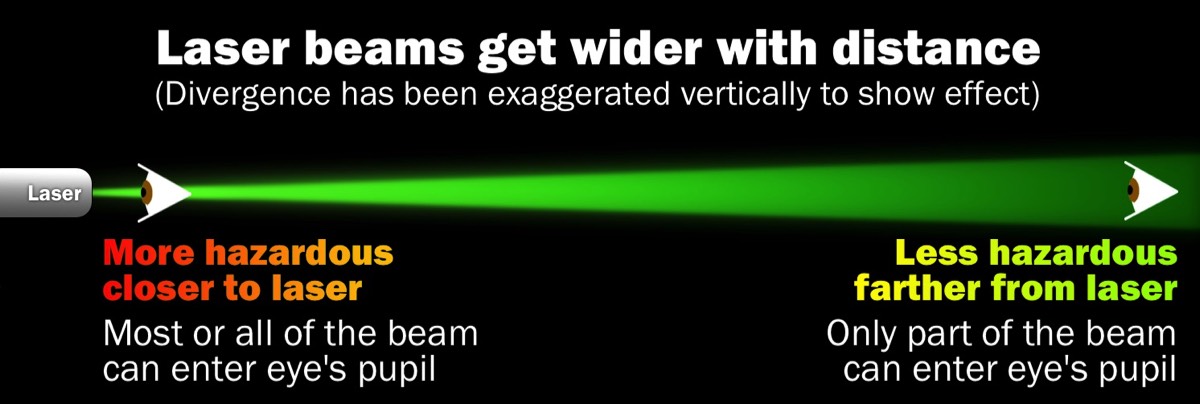
A human pupil is about 0.16-0.28 inches (4-7 mm) across, depending on lighting conditions. If a beam is, say, 6 inches across, then clearly most of the beam power does not go through the pupil:
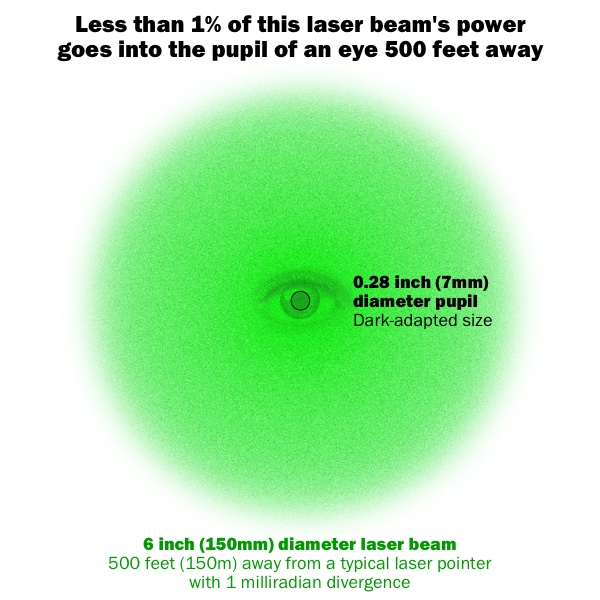
That’s why a laser beam that can pop balloons or light cigarettes up close, could be eye-safe hundreds of feet away.
Now, an eye-safe beam may still be very bright. It could cause temporary flashblindness, or vision-blocking glare, or be a distraction. This would be a hazard to persons such as pilots during critical phases of flight. The second part of the calculator above lists the distances for those visual interference hazards.
-
Some sample eye hazard distances
- If a laser pointer had an output power of 5 milliwatts and a beam divergence of 1 milliradian, the beam would be considered eye safe for momentary exposure (blink or turn away within 1/4 second) after about 50 feet. At 500 feet, even deliberate staring into the beam would not cause an injury.
For a stronger beam such as 499 milliwatts — the highest power Class 3B laser — the beam would be considered eye safe for momentary exposure after about 520 feet.
The “eye safe” distance is called the Nominal Ocular Hazard Distance, or NOHD.
The NOHD has a built-in safety or reduction factor. As the color-coded diagram below indicates, a laser beam is most hazardous at close range (red), and gradually becomes less hazardous until at the NOHD the chance of an injury is considered “vanishingly small.”
The ED50 distance is about 1/3 of the NOHD. At the ED50 distance, there is a 50/50 chance of the laser causing the smallest medically noticeable retinal lesion under laboratory conditions where both the laser and the eye are stationary. Often such a lesion will heal, in the same way that a minor skin burn can heal. Beyond the ED50 distance, the chance of having a retinal lesion is further reduced.
For a 5 mW 1 mrad laser, the ED50 distance is 16 feet. For a 499 mW 1 mrad laser, the ED50 distance is about 164 feet.
This helps explain why a laser that is nominally hazardous at a certain distance (the NOHD) is extremely unlikely to cause even a small injury at that distance.
There is more information about the NOHD and the ED50 distance on this page. -
Technical details about the pupil-beam comparison
- The illustration above compares a 7 mm dark-adapted pupil to a 150 mm diameter laser beam. The title states that “Less than 1% of this laser beam’s power goes into the pupil of an eye 500 feet away”.
As with so many aspects of laser hazards, there are important details to consider.
The beam is brighter in the center
The area of a 7 mm diameter circle compared with a 150 mm diameter circle is 38.5 mm2 divided by 17,671 mm2, or 0.0022 which is also 0.22%. Said another way, a 7 mm circle’s area represents only 0.22% of a 150 mm circle’s area.
However, the center of a typical laser beam is brighter than the edges. If a person’s pupil was in the center as illustrated, it would receive more than 0.22% of the light.
The exact exposure would depend on what part of the laser beam went in the eye. To be conservative, we simply state that a 7 mm pupil would receive “less than 1% of the laser’s light”.
A smaller pupil is safer
Another aspect in many or perhaps most laser exposure incidents is that the pupil may be smaller than 7 mm, meaning it lets in less laser light.
A completely dark-adapted pupil is generally 7-8 mm in diameter. But for a pilot in an aircraft, their pupil is NOT dark-adapted. There are instrument displays and lights in the cockpit, and city lights (when landing) outside the cockpit.
Let’s say the pupil is more constricted, at 5 mm. This has an area of 19.6 mm2, which is half of the 38.5 mm2 area of a 7 mm pupil. This increases safety — only half the amount of laser light can get through the pupil and onto the retina, compared to a completely dark-adapted eye.
A moving beam is less hazardous
Yet another aspect that increases safety is that the laser light is moving, relative to the pupil.
If the laser light is always focused on the same area of the retina, this allows heat to build up. But in many situations where a person is trying to avoid a laser light being hand-aimed at them, the light is moving relative to the eye.- This movement may be because of the inherent difficulty of keeping a laser beam on target over hundreds of feet. (You can see this in videos of lasers being aimed at helicopters, where the beam only occasionally hits the camera lens. Each frame below is 1/30 of a second; only one of the frames is a direct hit on the lens.)
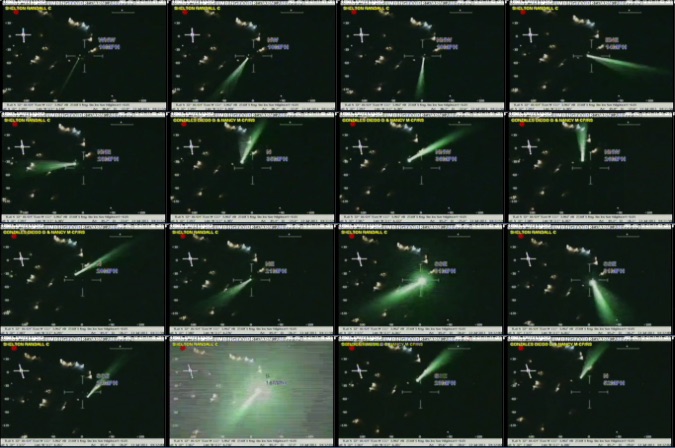
- This movement may also be due to the illuminated person moving their head and eyes to avoid directly staring into the beam.
In both cases, the laser light does not have as much time to stay on one spot on the retina. This reduces the chance of causing a lesion or burn.
Of course, if a laser is powerful enough and a person is close enough — say, within the NOHD and certainly within the ED50 distance — a brief 1/4 second exposure can cause a retinal lesion.
But for laser illuminations of pilots at aircraft distances of many hundreds or thousands of feet, even powerful lasers are considered by experts to be unlikely to cause serious or permanent harm.
A special message for laser pointer users
Plus, laser incidents create a bad image and can lead to laser pointers being banned. This has happened in a number of areas. (In New South Wales, you can be fined for possessing a laser pointer, and you can go to jail for up to 14 years for a laser assault.) There are strong calls in Canada, the U.S., and the U.K. to restrict or ban lasers.
It is really simple: NEVER aim a laser beam at an aircraft, a vehicle, or towards strangers. In other words, DON’T ANNOY PEOPLE WITH THE LASER BEAM.
For more specific information about laser pen hazards and safe use, see the various topics in the menu at left. For a quick summary aimed at consumers, check out the FDA’s December 2010 safety notification.

